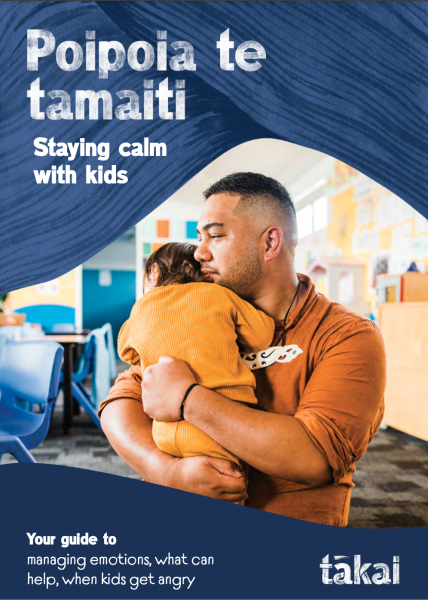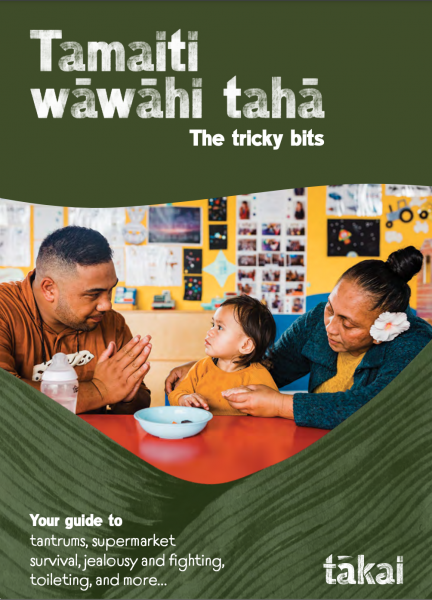Key points about tantrums
- most tamariki will have tantrums - it is a normal part of their development
- tantrums can look different in different tamariki
- for young tamariki, tantrums happen when they’re overwhelmed by strong emotions
- you can reduce tantrums by looking out for tantrum triggers and avoiding them
- having a plan for how to manage tantrums can help you support your child when they happen
What are tantrums?
A tantrum is an outburst of strong feelings. Tantrums can look different in different tamariki. You may see screaming, kicking, running away, or falling down. Some tamariki may hurt themselves or other people during a tantrum.
Why tantrums happen
Younger tamariki may not have the words or actions to express their emotions. Some tamariki can have tantrums if they are overwhelmed.
Common triggers that lead to tantrums include:
- tiredness
- having a busy day
- stress
- feeling overwhelmed
- feeling strong emotions such as worry or anger
- not knowing how to cope with a situation such as another child taking away a toy
- hunger
How you can reduce tantrums
Being prepared for situations when a tantrum may happen can help you to manage it. Here are some other ways you can reduce the chance of tantrums happening.
Video of a Dad's experience with tantrums in his tamariki.
Source: Tākai
Routine
Follow a routine with your child and stick to it where possible. If your child knows what to expect and when to expect things, it can help reduce the chance of tantrums.
Choices
Offer your child choices where possible. This helps them to learn independence which can prevent power struggles.
Communication
Some tamariki will have tantrums because they can’t express their feelings. Encourage your child to express themselves by using their words and actions.
Teach your child simple phrases and words for different feelings - words and phrases they can understand. You can do this from birth by using words to label feelings like ‘happy’, ‘sad’, ‘tired’ and ‘hungry’.
Know triggers
Pay attention to situations or events that often lead to tantrums in your child. If you know which triggers are likely to cause a tantrum, try to take steps to prevent them.
Model calm behaviour
This can be difficult. Tamariki often copy the behaviour of the adults around them. Practice staying calm and patient during difficult situations. Be aware of your own emotions and how you’re expressing them. Your behaviour sets an example for your child to follow.
How to support your child during a tantrum
Sometimes tantrums happen. How you handle tantrums depends on your child's age.
With toddlers, stay with them and give them comfort. Let your child know you understand how they feel. Showing love supports tamariki to feel safe and manage big emotions.
For older children, you can also try these 5 steps to help them calm down:
- ask them to identify the emotion they are feeling
- name the emotion
- take a pause
- support your child as they calm down
- talk about the issue that caused the tantrum
Alongside supporting your child during a tantrum, it’s important they are safe. Sometimes you may need to carry your child somewhere else. Once they are in a safe place, acknowledge the emotion they are showing.
Stay quietly and calmly with your child until they calm down. Be consistent about not giving in to demands. This will help your child learn that tantrums don’t help them get what they want.
How to manage your own feelings during a tantrum
Staying calm while your child has a tantrum will help model calm behaviour. Here are some ways to help you remain calm if your child is having a tantrum:
- have a plan for tantrums and use it when they happen
- remember you can’t control your child's emotions, but you can keep them safe and guide their behaviour
- try to keep a sense of humour
- remember tamariki grow out of tantrums
- focus on your child rather than judgement from strangers
- talk to friends and whānau about your experiences and ask them for support
Sometimes the frustration parents and whānau experience can turn into anger. Tamariki learn how to manage their emotions by watching people around them. If you let your anger out in harmful ways, it hurts your kids. It can damage your relationship with them and can make tantrums worse.
Tākai has a resource with tips and suggestions on ways you and your child can manage emotions in a healthy way.

Source: Tākai
Where to find help and support
Childhood tantrums can be stressful and frustrating for parents and whānau. If you are finding it difficult, there is support available.
You can contact your Well Child provider or health professional if you are finding it challenging to manage this phase.
You can also contact PlunketLine for free advice and support.
PlunketLine is available 24 hours a day, 7 days a week, on 0800 933 922 for advice and support for you, your baby and your whānau. Calls are free from cell phones. You do not need to be registered with Plunket to use this service.
Where to learn more about managing childhood tantrums

The Raising Children Australia website has more information on why tantrums happen and how to manage them.

Take a look at the Plunket website for more information on how to deal with tantrums.
Resources on managing childhood tantrums
The tricky bits is a resource developed by Tākai. It includes some helpful ways to deal with tantrums. As well as tantrums, the booklet has tips about surviving the supermarket, jealousy and fighting and learning to use the toilet.

Source: Tākai

